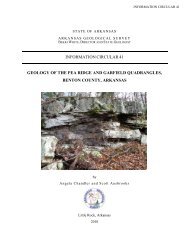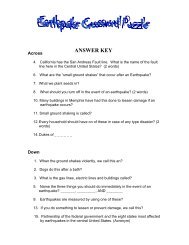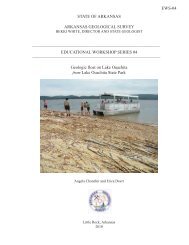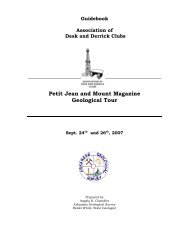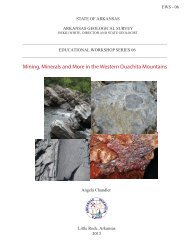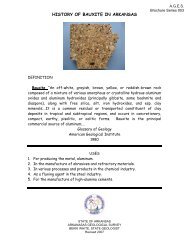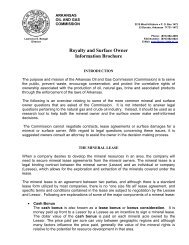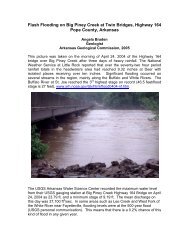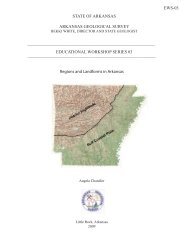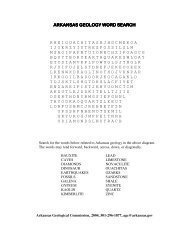Collecting Fossils in Arkansas pdf - Arkansas Geological Survey
Collecting Fossils in Arkansas pdf - Arkansas Geological Survey
Collecting Fossils in Arkansas pdf - Arkansas Geological Survey
You also want an ePaper? Increase the reach of your titles
YUMPU automatically turns print PDFs into web optimized ePapers that Google loves.
<strong>Collect<strong>in</strong>g</strong> <strong>Fossils</strong> <strong>in</strong> <strong>Arkansas</strong>Fossil collect<strong>in</strong>g is a fun activitythat should be approached responsibly. <strong>Arkansas</strong> has manylocationsthat offer great opportunities tocollect fossils. The best places tosearch <strong>in</strong>cluderoadside outcrops, streams cutsand old quarries. <strong>Fossils</strong> are the property ofthe land owner.Always ask permission before enter<strong>in</strong>g private property. Vertebrate fossils are protected onmost public land but<strong>in</strong>vertebrate rema<strong>in</strong>s are usually available for collection. If you are unsureabout the regulations on public land, pleasee contact thee agency <strong>in</strong> charge of the land on whichyou wish to collect. State and National Parksare off limits.Remember to be safe when collect<strong>in</strong>g fossils. Proper cloth<strong>in</strong>g, <strong>in</strong>clud<strong>in</strong>g footwear, glovesandsafety glasses are essential. Always be m<strong>in</strong>dful of traffic, and <strong>in</strong> the summertime beware ofsnakes, spiders, ticks and chiggers. Most importantly, have fun, but be patient and carefulwhen you collect.What to write down: A good scientist takes good notes. .Geographic location: Take a GPS read<strong>in</strong>g A legal description(State, county, topo quad, section, township, range, ..) Verbal description(“200 feetsouthwest of the bridge over Peyton Creek”) Keep a record of land ownerscontact <strong>in</strong>formation<strong>Geological</strong> Information:The tools you will needA good rock hammer (not a nail hammer), chisel, safetyglasses, samplebags, labels, markers and mapss are essential tools forfossil collect<strong>in</strong>g.It is very important to properly note your collect<strong>in</strong>glocation. Manycollectors loose vital <strong>in</strong>formation about their fossil f<strong>in</strong>ds by forgett<strong>in</strong>gto take good notes. Here are some helpful h<strong>in</strong>ts: Rock type (For example, “cherty limestone, sandstone, shale, micrite, etc…”) <strong>Geological</strong> formation (This can be determ<strong>in</strong>ed by f<strong>in</strong>d<strong>in</strong>g your location on a<strong>Geological</strong> Map of <strong>Arkansas</strong>. For further details about <strong>Geological</strong> Formationconsult the “Stratigraphic Summary of <strong>Arkansas</strong>”) Keep a field journal with youwhen you collect. Record your observations,drawpictures of what you f<strong>in</strong>d, take pictures and measurements.
What toknow before you go<strong>Arkansas</strong>s is divided <strong>in</strong>to 5 physiographic regions based on geology. Fossil collect<strong>in</strong>g is possible <strong>in</strong>all regions, but is it important tohave a handle on <strong>Arkansas</strong> geology before you head <strong>in</strong>to thefield. A little researchbefore yougo never hurts. Here iss a helpful overview of <strong>Arkansas</strong> geologyby region.The Ozark PlateausThe geology of the Ozark Plateaus Region is characterized bysedimentary rock deposited mostly by shallow mar<strong>in</strong>e seas(where a variety of animals could live) fromthe Ordovicianthrough the Pennsylvanian Period mak<strong>in</strong>gthis the mostfossiliferous region <strong>in</strong>n the state.The Salem Plateau conta<strong>in</strong>s theoldest rock present and ismade up of dolostone, limestone andsandstone ofOrdovician age. Algal structures called stromatolites,corals, brachiopods, bryozoa, cr<strong>in</strong>oids,gastropods, and some cephalopods are the fossils mostt commonlyfound <strong>in</strong> the limestonee anddolostone. Trilobite fragments are less common but are present <strong>in</strong> these strata. The St. PeterSandstone conta<strong>in</strong>s the vertical trace fossil Skolithos. Silurian and Devonian strata are limited <strong>in</strong>their outcrop area. Silurian limestones conta<strong>in</strong> cr<strong>in</strong>oids, trilobitefragments,and small algalmounds. Devonian strata are usually unfossiliferous.The Spr<strong>in</strong>gfield Plateau is made up of limestone, sandstone,shale, and chert fromtheMississippian Period. Corals, bryozoa, brachiopodss, cr<strong>in</strong>oids, bivalves, cephalopod, andgastropods are common <strong>in</strong> these rock types. Trilobite fragments are less common but arepresent <strong>in</strong> these rock types as well.Ech<strong>in</strong>oid fragments are present <strong>in</strong> the Boone Formation.Starfish and bivalve rest<strong>in</strong>g traces called Asteriacites and Lockeia respectively,and worm trailsare common at certa<strong>in</strong> localities <strong>in</strong> the Batesville Sandstone.Mississippian age shales offer the easiest collect<strong>in</strong>g of fossils <strong>in</strong> the Ozark Plateau Region. Shaleweathersrapidly to mud, which washes away leav<strong>in</strong>g the fossils beh<strong>in</strong>d. Theree are three majorMississippian age fossiliferous shale units <strong>in</strong>north <strong>Arkansas</strong>. From oldest to youngest they arethe Moorefield Shale; the Fayetteville Shale;and the Imo member of the Pitk<strong>in</strong> Formation.Fayetteville and Moorefield Shales – Ammonoids and nautiloids are the mostcommon fossilspresent. Fossil fauna <strong>in</strong> the Fayetteville Shale are oftenn replaced by iron sulfide (pyrite). Plantfossils are less common <strong>in</strong> the Fayetteville Shale but aree present locally.
Imo member of Pitk<strong>in</strong> Limestonee – This unitoutcrops <strong>in</strong>n limited areas of Searcy and Van BurenCounties. It conta<strong>in</strong>s an abundant, diverse, and well preserved fauna <strong>in</strong>clud<strong>in</strong>g ammonoids,nautiloids, bivalves, brachiopods, bryozoan, plant material, blastoids, cr<strong>in</strong>oids, gastropods,shark teeth, and trilobites. Plantfossils are also presentt <strong>in</strong> this unit. .The Boston Mts. Plateau is made up of Pennsylvanian age rocks. Itt conta<strong>in</strong>s mostly sandstone,siltstone,and shale, however limestone is present at various localities. Trace fossils such asConostichus, Zoophycus, and Asterosoma are most commonly found <strong>in</strong> sandstone and siltstoneof this region. Plantfossils are not abundant but are present <strong>in</strong> the sandstone, siltstone, andshale. Limestone <strong>in</strong> this region is usually fossiliferous and conta<strong>in</strong>ss cr<strong>in</strong>oids, blastoids, bryozoa,brachiopods, corals, and ammonoids.<strong>Arkansas</strong> River ValleyThe <strong>Arkansas</strong> River Valley is characterizedby sedimentaryrocks deposited by river systems flow<strong>in</strong>g from the northandeast dur<strong>in</strong>g the Pennsylvanian Period. This area representsthe northern extent of the Ouachita orogenic (mounta<strong>in</strong>build<strong>in</strong>g) system <strong>in</strong>n<strong>Arkansas</strong>. Once flat‐ly<strong>in</strong>g,thesePennsylvanian sedimentary rocks have been compressed<strong>in</strong>towell‐developed east‐west trend<strong>in</strong>g open folds (anticl<strong>in</strong>esandsyncl<strong>in</strong>es) and faults, which gradually dim<strong>in</strong>ish northward<strong>in</strong>tothe Ozark Plateau Region. Pennsylvanian sandstones, shalesand siltstones often conta<strong>in</strong> abundant plant fossils. Lepidodendron, Calamities, Stigmaria, andfossil ferns may be discovered. Trace fossilss such as Conostichus arepresent locally <strong>in</strong> siltstones<strong>in</strong> the area.Sandstones at various localities conta<strong>in</strong> ammonoids, cr<strong>in</strong>oids, gastropods,brachiopods, and bivalves.Ouachita Mounta<strong>in</strong>sThe Ouachita Mounta<strong>in</strong>s Region conta<strong>in</strong>s thick sequences ofsedimentaryrocks deposited <strong>in</strong> a deep ocean bas<strong>in</strong> that havebeen uplifted and compressednorthward <strong>in</strong>to east‐westand thrustfaultsdueto majororogenic(mounta<strong>in</strong>build<strong>in</strong>g)processes. The most <strong>in</strong>tensely deformed area is <strong>in</strong> the centralportion of the fold belt. The rocks <strong>in</strong> the Ouachita Mounta<strong>in</strong>strend<strong>in</strong>g complex foldss (anticl<strong>in</strong>ess and syncl<strong>in</strong>es)
are sparsely fossiliferous but some units, notably the Ordovician age Womble Shale, conta<strong>in</strong>graptolites. At one locality, trilobites are present and date the oldest rocks <strong>in</strong><strong>Arkansas</strong> <strong>in</strong> thecentral Ouachitas. Worm trails are present <strong>in</strong> shale at various localities.West Gulf Coastal Pla<strong>in</strong>The West Gulf Coastal Pla<strong>in</strong> is characterized by gentlysouthward‐dipp<strong>in</strong>g sedimentaryrocks deposited mostly <strong>in</strong>shallow mar<strong>in</strong>e water of the Gulf of Mexico that onceextended <strong>in</strong>to <strong>Arkansas</strong>. The area <strong>in</strong> orange consists ofTertiary clays, sands and silts with lignite deposits andQuaternarygravels, sands and clays. Thearea <strong>in</strong> greenconsists of Cretaceous age formations.Some of theCretaceousunits are very rich <strong>in</strong> fossils. Oyster, ech<strong>in</strong>oid,gastropod and cephalopod fossils are most commonly found. The Cretaceous rocks are theonlyrocks outcropp<strong>in</strong>g <strong>in</strong><strong>Arkansas</strong> that were deposited dur<strong>in</strong>g the Age of D<strong>in</strong>osaurs. It is only fromthese rocks that d<strong>in</strong>osaur fossils have ever been found <strong>in</strong> the state. In addition to thefewd<strong>in</strong>osaurbones (Arkansaurus fridayi) a largenumber off d<strong>in</strong>osaur tracks are know from a LowerCretaceous limestone that outcrops <strong>in</strong> a limited area. Other vertebrate fossils discovered <strong>in</strong> thearea <strong>in</strong>clude shark teeth, mosasaur, reptile teeth and plates, and miscellaneouss fish parts. Mostof these rocks are not as hard asthe Paleozoic rocks, soo collect<strong>in</strong>g is fairly easy. Petrified woodhas beendiscovered <strong>in</strong> Quaternary terrace deposits andd amber is present locally <strong>in</strong> Tertiary agedeposits.Mississippi Alluvial Pla<strong>in</strong>The geology of thee Mississippi River Alluvial Pla<strong>in</strong> ischaracterized by unconsolidated, flat‐ly<strong>in</strong>g alluvium frompresent dayand older streams, overly<strong>in</strong>g poorly consolidatedTertiary formations.Petrified wood is occasionally foundassociated with gravel deposits of Quaternary age <strong>in</strong>theMississippi River Alluvial Pla<strong>in</strong>. Iceage mammal fossils such asmammoth, mastodon, dire wolf, saber‐tooth cat, bear, groundsloth, peccary, and more have alsobeen discovered <strong>in</strong> gravelsof the Mississippi River. Oysters, gastropods, bivalves, shark and ray teeth, andplant fossils arepresent <strong>in</strong> Eocene age formations along Crowley’s Ridge.



